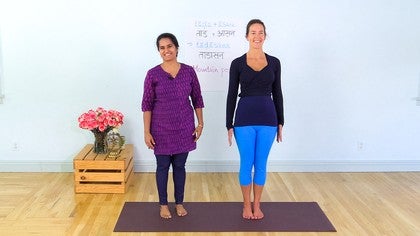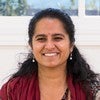Description
About This Video
Transcript
Read Full Transcript
Namaste, dear friends and welcome again to the Sanskrit Yoga session. Today we are going to introduce the different body parts and see how they are pronounced in Sanskrit. Start with the head, shirsh, sometimes they also say mastaka or just shiraha. But in the asanas you find it often pronounced as shirsh, again shirsh, lalata, lalata, lalata, nithra, nithra, nithra, karna, karna, karna, nasi ka, nasi ka, nasi ka, kapolaha, kapolaha, mukham. Now the word mukham can refer to mouth or it can refer to the whole face.
So mukham or mukha, mukha, mukha. We go inside the mouth, we have dantha, dantha. You got to make sure you are pointing only at one tooth there, dantha, dantha, jihwa, jihwa, jihwa. The lips are known as oshta, oshta, cibuka, cibuka, cibuka, kantha, kantha, kantha. Sometimes they also use the word greever, but kantha or greever, bhuja.
The whole arm is bhuja, bhuja, skandha, skandha, skandha, hasta, hasta, hasta, hasta, hasta, hasta, anguli, anguli. The finger in general is known as anguli. The thumb and the toe are angushta, angushta, angushta, vaksha, vaksha, vaksha, udara, udara, udara. And right at the center, the navel is known as naabhi, naabhi, naabhi, great. The front is also known as purva, you can say purva.
You go to the back, prishta. The word prishta can refer to the entire back, but very literally also just the back itself. Prishta, prishta, prishta. One of the words for the hips is nithamba, nithamba, nithamba. The thighs, uru, uru, uru.
The knees are very important, so janu, janu, janu. And then the foot, padha, padha, padha. And the big toe is the angushta, angushta or padangushta. The foot, toe, big toe, padha, angushta, together is padangushta, say that, padangushta, lovely. The sides of the body or the side of anything is normally known as parshwa, parshwa, great.
I hope you've got that, we'll play a small game. You know the Simon says, we'll do the yoga version. I'll say Shiva says, and let's see if you can point it out, okay? Let's go. Shiva, Shiva says, Shiva, did you do that?
Great. The rah, Shiva says, udah rah, did you get that? Brilliant. Padha, Shiva says, padha, touch your padha. Did you get it?
Yes. Everybody in the yoga world knows the padha, that's the padha. Okay, hasta, Shiva says, show your hasta, yes, brilliant, that's it, hasta. One more, karna, karna, Shiva says, show your karna, that's it, great. Another one, Shiva says, prishta, prishta, show your prishta, lovely, that's it, and oh, an important one, janu, Shiva says, show your janu, got it?
Yes, that's it, janu, janu, mukha, Shiva says, show your mukha, lovely. Did you do that as well as that? Great, mukha and mukha. I think you're doing a great job. Let's just once go through the body parts so that we are sure we are saying the same thing and showing the same thing.
Let's start with the head, shirusha, shirusha, lalata, lalata, netra, netra, karna, karna, kapula, kapula, nasi ka, nasi ka, mukha, mukha, or mukha, mukha, danta, danta, jihua, jihua, jihua, jihua, jihua, jihua, jihua, jihua, jihua, jihua, jihua, jihua, jihua, jihua, skana, hasta, hasta, anguli, anguli, angushta, angushta, vaksha, vaksha, udara, udara, prashta, nithamba, nithamba, uru, uru, jhanu, jhanu, padha can mean the full leg as well as just the foot itself. So, padha, padha, angushta the toe or padangushta, padangushta, pashwa meaning the side, pashwa, purva and prishta. Got it? Great! Now let's see them used in the postures themselves. Hope you stay with me. Bye-bye.
Mother Tongue: Pronouncing the Postures
Comments
You need to be a subscriber to post a comment.
Please Log In or Create an Account to start your free trial.










